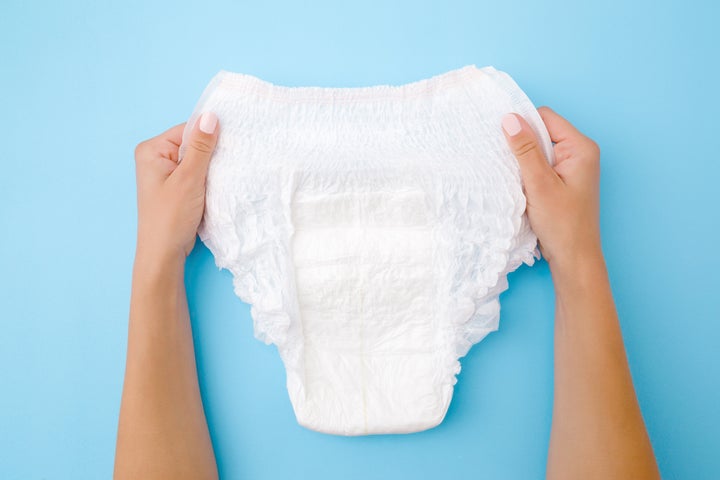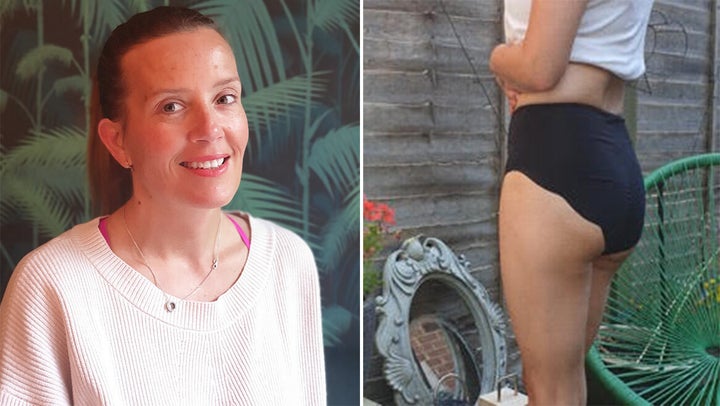Listen to our weekly podcast Am I Making You Uncomfortable? about women’s health, bodies and private lives. Available on Spotify, Apple, Audioboom and wherever you listen to your podcasts.
“I’d really like to not get adult nappy rash,” says Luce Brett, 43, who’s been using incontinence pants for over a decade. “You have to use Sudocrem. And Sudocrem does not go with black opaque tights in the winter. You can end up with a real mess down there.”
Brett has experienced incontinence since she gave birth to her first son at the age of 30 and has reluctantly used continence pads and pants ever since.
The products are “undeniably very useful” and have “saved many women’s lives”, says Brett, author of PMSL: Or How I Literally Pissed Myself Laughing and Survived the Last Taboo to Tell the Tale.
But they rarely feel comfortable or sexy.
Incontinence is common, impacting an estimated one in three women in the UK, yet stigma surrounding the problem is rife. It’s why we tackled the topic on Am I Making You Uncomfortable?, HuffPost UK’s weekly podcast on women’s health, bodies and private lives.
Incontinence’s image isn’t helped by the dominate pads and pants on the market, which are typically large, white and made of material that rustles. Elaine Miller, a pelvic physiotherapist-turned-comic, thinks the products need a rebrand – and a possible redesign.

“My problem with pads is that the glue they use is rubbish,” she says in her stand-up show, Gusset Grippers, which is all about breaking incontinence taboos. “It’s either like fast setting cement, which sticks solidly to your pants, or it’s so ineffective that the pad unfurls as you walk – and sticks itself on to you. Only, you don’t realise that until you try to sit down and it tugs on your pubes. This is why women with incontinence wriggle when they sit.”
Speaking to HuffPost UK, Miller says she doesn’t want to demonise continence pads, because they do help a lot of people and allow women to move in society without as much worry.
“Not everyone will be dry with treatment. People with incontinence already feel shame and embarrassment – pads should not be seen as a sign of failure to do pelvic floor exercises or failure to fix a problem. They are a very effective solution for people for whom all other measures have been exhausted,” she says. “The problem with continence pads is that they are so stigmatised that many women won’t purchase them.”
Around 50% of maxi pads sold are bought for bladder and not menstrual leaking, says Miller, despite the fact that they’re designed for periods, not incontinence.
“Urine is not viscous like periods are, so urine can temporarily pool on the top of a menstrual pad and cause vulval irritation,” she says. “Equally, using a pad which is too absorbent can dry the vulval tissue, again that also causes irritation.”
Another problem with traditional, one-use continence pads is their environmental impact. “They are made of plastic and each one takes 500 years to decompose, which with an ageing population is an imminent and massive problem for landfill,” says Miller. “There are effective washable and compostable options out there, but it is the plastic ones which are most readily available for sale in supermarkets.”
Unsatisfied with the options dominating the market, one mum from Croydon, home-made some reusable continence pants for herself – and turned them into a business after some encouragement from friends.
Kelly Newton, 49, began experiencing incontinence after the birth of her second son 18 years ago. Newton, who’s also a foster carer, remembers feeling something wasn’t right just hours after giving birth.
“I was still in hospital, it was about four o’clock in the morning and he’d woken up for a feed. I was trying to quietly change him and a nurse came through the door. She startled me and I completely wet myself,” she recalls. “I remember sneaking out and trying to get to the bathroom to get some tissue to clean it up, but leaving a trail of wee behind me. It was absolutely mortifying.”
For almost two decades, Newton tried physio and had surgery to try to cure her incontinence, but nothing worked. She tried continence pads and pants from her local supermarket, as well as various “period pants”, some of which can also be used for bladder leaks. But she didn’t find anything that worked for her.
“I might be 49, but I still like to look after myself. I still want to wear nice clothes and I don’t want a big bulge in my knickers,” she says. “You get that with the Tena pads, but also will some of the washable knickers that are on the market.”

Many designs for larger leaks are also audible, says Newton, who describes the pants as feeling like “paper”. “They’re crinkly when you walk, you can hear it crackling and I don’t want everyone to know my business,” she says.
Her frustration came to a head after she’d joined a new hockey team and scored a goal, while wearing a thin liner.
“I jumped up and celebrated and just wet myself,” she says. “I didn’t know any of the women. A couple of people looked down their noses at me, but one lady was really sweet and said: ‘Oh don’t worry, I do that all the time when I’m running.’”
Newton bought some absorbent material and made her own pants at home. Once she was more established in the team, her friends at hockey used to joke: “Have you got your special knickers on today, Kelly?” One of them suggested she market the knickers for other women in her situation.
It took a couple of years of research, a long search for a manufacturer, the sourcing of sustainable material and £1,500 to get a sample made, but last June her start-up, BP3 Underwear, was born. The company specialises in no-VPL knickers for sporty women facing incontinence. The knickers also work for periods, but unlike most duel-use period pants on the market, incontinence is front and centre of BP3′s marketing. The brand has already picked up the 2020 Editor’s Choice award from Women’s Running Magazine.
The biggest brands in the business are starting to evolve, too, with alternatives to the stereotypical big, white knicker slowly hitting shelves. Last year, Tena launched a new range of black incontinence pants called Silhouette Noir, after research from the company found women want products that closely replicate regular underwear.
Lisa Myers, the marketing manager at Tena, tells HuffPost UK, this is all part of the brand’s mission to help “women to feel sexy, confident and able to wear what they like without being restricted by the colour or shape of their underwear, something we believe is an important step towards normalising incontinence”.
But Miller is concerned that “normalising” incontinence is problematic in itself. A mantra repeated by physios working in this field is “incontinence is common, but it is not normal”. The idea is to encourage women to seek help, rather than simply “dealing with it” as if incontinence is to be expected.
“I take a very dim view of any advertising which implies that incontinence is a minor issue and I’d like to see action taken against adverts which state that incontinence is normal or that pads are the solution,” says Miller.
“Incontinence is a dreadful intrusion into a person’s life, I loathe the gas-lighting adverts which make light of the misery that bladder problems cause.”
Still, it’s progress to see more options being created for women and Tena tells HuffPost it is investing in ways to make its products more environmentally-friendly, to meet demand from customers.
Prices for Newton’s absorbent knickers start at £18 and she acknowledges that for some, cost may be a barrier to access. She’d like to see continence pads and pants subsidised for those who need them.
“I would like to bring my prices down definitely and do some kind of charity once my company is established more,” she says. “It’s not all about the money for me, it really isn’t. I’m doing it because it’s something that’s helped me and it’s been helping other women. It’s such a massive issue and yet there isn’t any government help or anything like that.”
For the market to evolve, Newton believes stigma around incontinence must be challenged further, so companies invest in better solutions – and women feel empowered to demand them.
“With period knickers, you didn’t hear about those until very recently. They weren’t particularly popular and everyone was a bit grossed out by them,” she says. “But they’re becoming more and more popular and I think the same will happen with incontinence. As embarrassing as it is, people need to be open about it.”